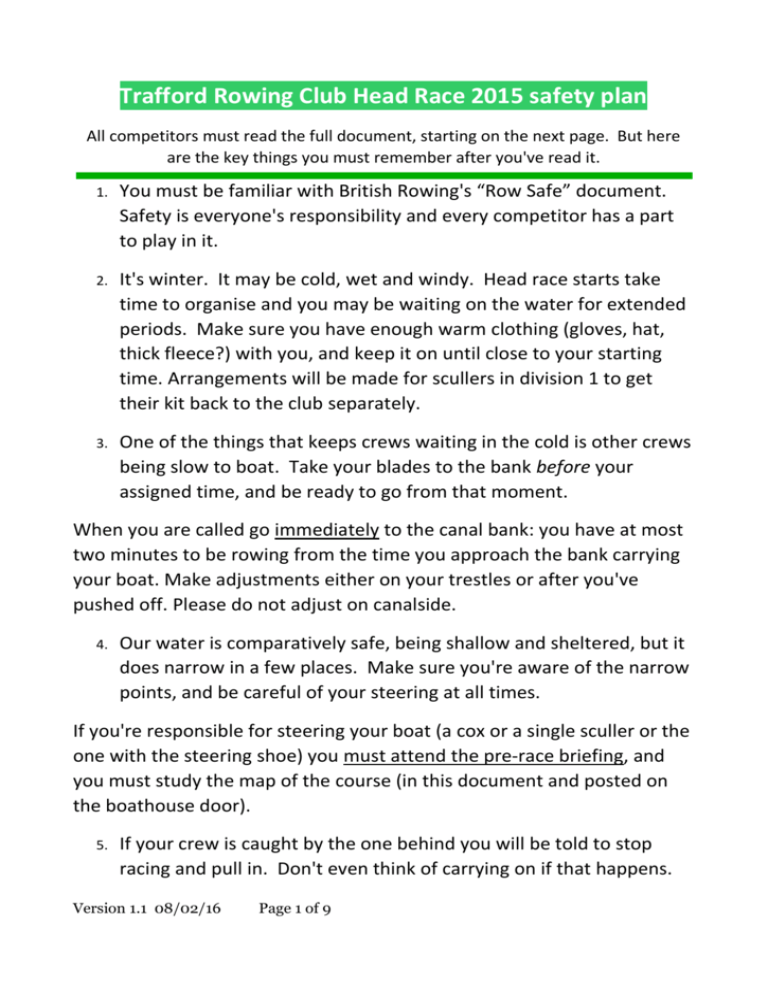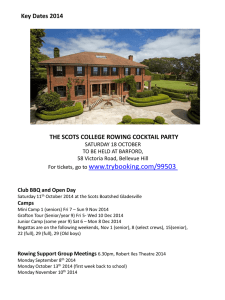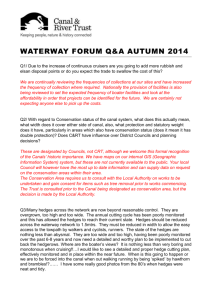TRC Safety Plan - Trafford Rowing Club
advertisement

Trafford Rowing Club Head Race 2015 safety plan All competitors must read the full document, starting on the next page. But here are the key things you must remember after you've read it. 1. You must be familiar with British Rowing's “Row Safe” document. Safety is everyone's responsibility and every competitor has a part to play in it. 2. It's winter. It may be cold, wet and windy. Head race starts take time to organise and you may be waiting on the water for extended periods. Make sure you have enough warm clothing (gloves, hat, thick fleece?) with you, and keep it on until close to your starting time. Arrangements will be made for scullers in division 1 to get their kit back to the club separately. 3. One of the things that keeps crews waiting in the cold is other crews being slow to boat. Take your blades to the bank before your assigned time, and be ready to go from that moment. When you are called go immediately to the canal bank: you have at most two minutes to be rowing from the time you approach the bank carrying your boat. Make adjustments either on your trestles or after you've pushed off. Please do not adjust on canalside. 4. Our water is comparatively safe, being shallow and sheltered, but it does narrow in a few places. Make sure you're aware of the narrow points, and be careful of your steering at all times. If you're responsible for steering your boat (a cox or a single sculler or the one with the steering shoe) you must attend the pre-race briefing, and you must study the map of the course (in this document and posted on the boathouse door). 5. If your crew is caught by the one behind you will be told to stop racing and pull in. Don't even think of carrying on if that happens. Version 1.1 08/02/16 Page 1 of 9 Head Race Saturday 21st February 2015 – Safety plan 1 Introduction This document identifies the risks involved in the event organised by Trafford Rowing Club (TRC) and outlines the procedures to be initiated by the organisers, officials and competitors to minimise the risk. It also gives information on local conditions, which will aid crews during the event. 2 Officials Position Name Safety Advisor Simon Reeves Deputy Safety Advisor Mark Hamer Umpires British Rowing Officials Race Control Simon Reeves Race marshal – Finish Line Trafford Rowing Club Member Race marshal – Timperley Bridge Trafford Rowing Club Member Race marshal – Viaduct Road Trafford Rowing Club Member Race marshal – Manchester Road Bridge Trafford Rowing Club Member Race marshal – Start Line Trafford Rowing Club Member Car Park marshal Trafford Rowing Club Member All race marshals on the course will be wearing hi-visibility jackets for easy identification. Race control and event registration, together with first aid provision, is located at the Scout Hut. This is on the left as you enter the boating area at Walton Park Sports Centre. 3 Rules Applying to the Event 1. The event is run under the British Rowing “Rules for Racing.” 2. This Safety Plan includes notes for competitors on local conditions and will be sent out with confirmation of entry. 3. British Rowing's “Row Safe” publication is used for the basis for this plan; all competitors will be expected to comply with it. 4. Northwest Umpires Commission will provide umpires, who will be aided by marshals provided by TRC. 4 Weather 1. The race is held on a canal where the water is maintained at a fixed height. There is no stream. However canals are more prone to freezing than rivers. 2. In the event of freezing conditions, the canal may ice over completely or partially. Racing will then either be:Version 1.1 08/02/16 Page 2 of 9 a. Held as planned; b. Reduced in length with certain boats excluded; or c. cancelled. 3. Strong winds are sometimes funnelled by the high buildings to the West of Manchester Road bridge to the point of being dangerous. If this happens racing may be restricted to the stretch between the bridge and the clubhouse, or cancelled. The Marshalls either side of this building will also advise you if there are any issues 4. A decision on any changes due to weather conditions will be taken prior to each division. 5. As is common with head races, competitors may have to wait at the start for extended periods (up to an hour in some cases). Competitors must be suitably clad: if not they will not be allowed to boat. 5 Hazards 1. A map of the course is towards the end of this document. 2. The canal is narrow, particularly under bridges and next to the old stone viaduct. There is a continuous towpath on the Boathouse side of the canal. The towpath side is essentially smooth with only a few minor changes of width. The footpath has been upgraded for a large part of the course although can be muddy between the race start at Oldfield Marina and the Budenburg flats 3. The opposite side has frequent changes of width, some of them quite pronounced, and a number of overhanging trees. 4. There is also a waste water outlet just before the start by the crane. This outlet is automated and we cannot control when it is turned on. Occasionally crews approaching the start may need to be aware of this as it could impact on the progress of the boat. 5. Barges are moored by Timperley Bridge on the opposite side to the towpath. 6. There is limited visibility on bends, and some bridges cross the canal at an angle, which can be deceptive. Extra care must be taken when steering through bridges. 7. There may be obstructions or debris in the water. 8. The canal is officially closed between 09.00 and 16.00 hours by order of the Bridgewater Canal Company – however there maybe a need to allow some narrow boat movements between divisions (but not during racing.) If this is the case, competitors will be notified on boating and also by marshals on the course. If a canal barge comes from the opposite direction when you are rowing to the start, you must give way to let it pass. Pull in to the towpath (on starboard/bow side when heading towards the start), with blades on the bank. Do this when the oncoming narrow boat is no less than 100 meters away. 5 Risk Minimisation for the Course 1. There is no overtaking. Crews will be seeded and sufficiently spaced out in time so that the need to overtake should not arise. However, if a crew is caught by a following crew, it Version 1.1 08/02/16 Page 3 of 9 must pull into the bank (towpath side) in good time to allow the overtaking crew to proceed unhindered. The race marshals’ instructions must be followed at all times. 2. Scullers and coxless boats should steer parallel to the towpath. (stroke or right hand side when racing) 3. The course will be patrolled before racing to remove obstructions and to check there are no previously unidentified hazards 4. Where possible any overhanging branches will be pruned but, since the land is privately owned, this may not be possible everywhere so care is needed. 5. Bridges and bends where visibility is restricted will be patrolled by race marshals. Obey their instructions at all times. 6. The start and finish will be patrolled by race marshals to ensure that no canal cruisers enter the course during racing 7. A safety launch will be in the canal on the day of the race and will be positioned near to Timperley Bridge to assist in any emergency. A second launch will be positioned between Manchester Road bridge and westwards to the start at Oldfield Marina as a backup, in case the primary safety launch should be unusable. 8. Crews should remain in the centre of the canal while racing. 9. Clubs should ensure that their members are trained in capsize drill. 1. In the event of an accident crews must move their boat and blades to the towpath side. 6 Communications 1. Some race marshals will be provided with radios. All marshals will have mobile telephone contact with Race Control. 2. In the event of an emergency, the nearest official will call ‘Emergency, Emergency’ and all other radio users will observe radio silence and follow instructions given by that official. 3. Control will be provided with a mobile phone (see telephone list). Control will be in radio contact with the start and finish. 4. During the event the Scout Hut will be open at all times. The race control mobile number is in section 13 of this document. 7 Medical provisions A St Johns Ambulance first aid team will be on hand at the Scout Hut; the nearest accident & emergency facilities are at Wythenshawe Hospital. 8 Emergency Action Plan and Procedures 8.1 Incident on the Water In the event of competitors being injured, capsizing or being ill, crews should pull into the bank on the towpath side and contact the nearest race marshal. Version 1.1 08/02/16 Page 4 of 9 8.2 Incident on Land Competitors embark and disembark from the landing stage at TRC, where St John Ambulance will be based. 9 Emergency Procedure If the emergency services are required, follow this procedure: The race marshal should contact the Club and request the service and specify the location. If radios fail call the mobile at control (See section 12). The race controller at the Clubhouse will telephone for the required emergency service using the control mobile and dialling 999 Where time is critical, the race marshal may telephone directly. Alternatively residents with property backing onto the canal may be/should be approached. Version 1.1 08/02/16 Page 5 of 9 10 Access Points The canal has pedestrian access all along it from the tow path on the North-West bank (the clubhouse side, the side closer to Manchester). Vehicular access can be gained, either directly or with a short walk, from the following points along the course. Location Type of access Postcode Course finish (Walton Park) Vehicle and pedestrian. M33 4AG Timperley bridge (Park Road) Vehicle to the bridge, down stairs to the canal. WA14 5BZ Canal Road, SW of Timperley bridge. Vehicle and pedestrian Halford's Car Park (Manchester Road) Vehicle to the car park; short path to the canal WA14 5PZ bank. Oldfield Brow Marina (Yeofield Drive) Vehicle and pedestrian WA14 4UP Seamons Road bridge Vehicle on the road, narrow path down to the canal. WA14 5RB WA14 1TD Other than at Canal Road and Oldfield Brow there is no access from the SE bank (the side opposite the clubhouse, closer to Altrincham). 11 Start and Finish 11.1 Boating 1. A competent person appointed by the Club Safety Officer will inspect boats as they embark. Crews embarking from Dane Road (Manchester University) must pull into the landing stage for inspection before continuing. A copy of the guidance given to boat inspectors is included at the end of this document. Note the change of regulations recently prohibiting plastic bottles as a means of buoyancy. 2. All competitors will be notified of the time they must boat for their race and should ensure that their blades are on the bank before their boating time. Reminders will be given by loud hailer in the area of the boathouse shortly before boating commences for each division. To ensure the safe and efficient running of the event, crews which do not report to the landing stage at their allocated boating time may not be allowed to race. 3. All crews should have a number pinned on the back of the bow person/sculler and the coxswain for stern loaders. If you are using a bow loader, we would ask that the stroke person wears the number on their front. Version 1.1 08/02/16 Page 6 of 9 4. Each crew will also receive an adhesive number which should be fixed to the boat on strokeside (i.e the side of the boat that will be visible from the towpath during the race). 11.2 Local safety regulations For what we believe are valid safety reasons Trafford Rowing Club has a local requirement that heel release cords (aka “heel restraints”) may be no more than 50mm (2”) long; this is a more stringent restriction than that required by British Rowing. We accept that this regulation cannot be applied to visiting clubs in an event run under BR regulations, but inspecting marshals will draw crews' attention to release cords that are longer than this and strongly recommend that they be shortened in future. 11.3 Start 1. Eights must turn in the marina two hundred meters past the start. The canal is wide enough for fours to turn in the straight part of the marina but this should not be attempted by inexperienced coxes. Crews must line up in race order. 2. Race marshals will be at the marina to supervise turning. Crews must heed their instructions at all times. 3. Crews must be adequately dressed to protect themselves against the weather particularly when proceeding to and waiting at the start. Coaches, parents and guardians are asked to ensure that their crews have clothing appropriate to the prevailing weather conditions. If in the opinion of a race official, a competitor does not have adequate clothing for the conditions, then they will not be allowed to proceed to the start until the matter is addressed satisfactorily. 4. All competitors must familiarise themselves with the event rules. A briefing will be held for coxswains, scullers and steersmen prior to each division. 12 Telephone Numbers Control Simon Reeves 07837 663740 Safety Advisor Simon Reeves 07837 663740 Pre event contact Simon Reeves 07837 663740 Start contact By radio via control Finish contact By radio via control Emergency services Version 1.1 08/02/16 999 (works from any mobile) Page 7 of 9 Map of the Course Version 1.1 08/02/16 Page 8 of 9 Trafford Head of the Bridgewater 2015 Boat Inspection Criteria 1. Bow balls securely attached (examine rigorously if tape has been used), pointing forwards rather than upwards or sideways. Even with a regulation ball the bow of a boat is capable of seriously injuring someone on impact: accept nothing that is not clearly up to standard. 2. Heels of shoes to be able to rise no more than 50mm (2”), which is the width of three fingertips (maybe four for those with very small hands). Reluctantly accept shoes whose heels are “prevented from rising higher than the lowest fixed point of the shoe” since that is the BR rule, but cut no slack on it. 3. Heel release cords to be in good order (not rotten), well secured, and independent of one another; do not underestimate the force which can be applied by a rower struggling with trapped heels. 4. All rowers and coxes will be suitably clad at the start for the prevailing weather. At least two layers on the top half, one with long sleeves, and at least one layer of full-length trousers or leggings (unless it's an unnaturally warm day!). 5. All coxes will wear a Personal Flotation Device (life jacket). Its straps must be in good order, properly adjusted and worn on top of all other clothing. Invite cox to prove that life jacket is fitted correctly and not loose. 6. Coxes in front-loaders not to be too tight a fit. No automatic life jackets in front-loaders. 7. All boats to have watertight buoyancy compartments or retro-fitted buoyancy bags. Plastic bottles are not acceptable as additional buoyancy. Check with BR Umpire on Control Commission on current policy re buoyancy bags as this may differ from that of British Rowing; other regions apply a different criteria to that of North West Region. 8. Rudder lines, steering shoes, coxes' handles and the rudder itself to be securely attached and running smoothly. Version 1.1 08/02/16 Page 9 of 9







